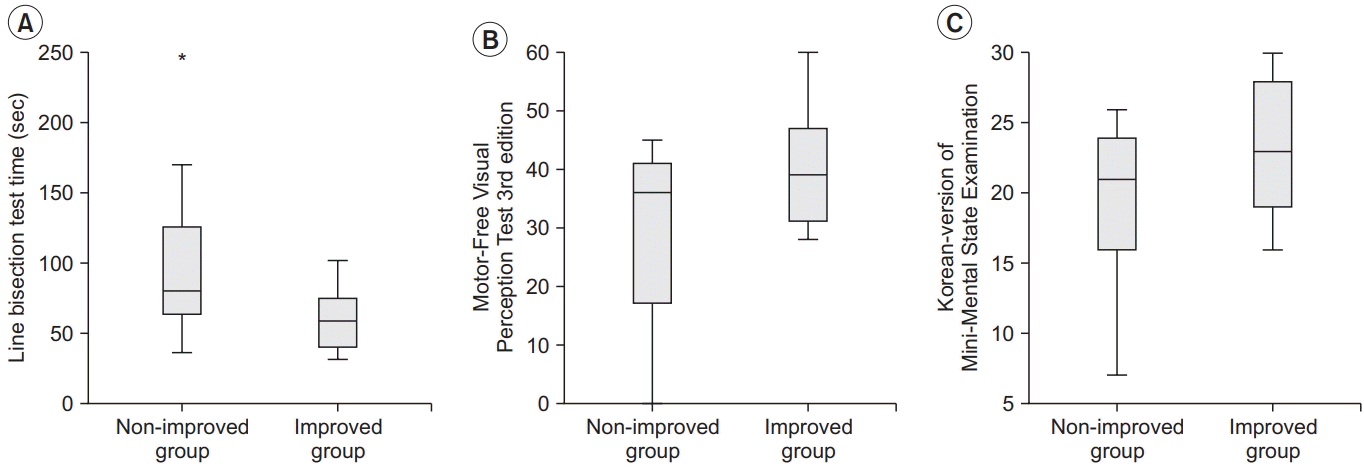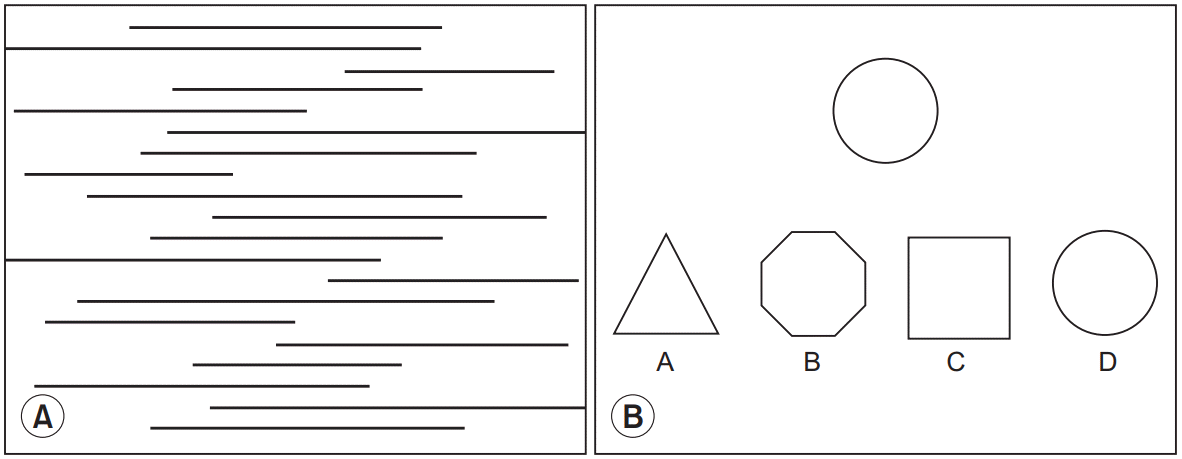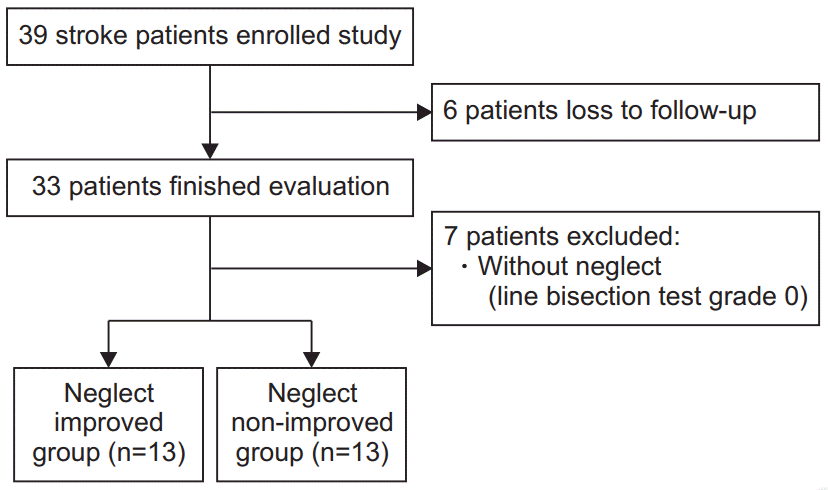1. Heilman KM, Bowers D, Coslett HB, Whelan H, Watson RT. Directional hypokinesia: prolonged reaction times for leftward movements in patients with right hemisphere lesions and neglect. Neurology. 1985; 35:855–9.

2. Vallar G. Spatial hemineglect in humans. Trends Cogn Sci. 1998; 2:87–97.

3. Bisiach E, Perani D, Vallar G, Berti A. Unilateral neglect: personal and extra-personal. Neuropsychologia. 1986; 24:759–67.

4. Stone SP, Wilson B, Wroot A, Halligan PW, Lange LS, Marshall JC, et al. The assessment of visuo-spatial neglect after acute stroke. J Neurol Neurosurg Psychiatry. 1991; 54:345–50.

5. Denes G, Semenza C, Stoppa E, Lis A. Unilateral spatial neglect and recovery from hemiplegia: a follow-up study. Brain. 1982; 105:543–52.
6. Jehkonen M, Ahonen JP, Dastidar P, Koivisto AM, Laippala P, Vilkki J, et al. Visual neglect as a predictor of functional outcome one year after stroke. Acta Neurol Scand. 2000; 101:195–201.

7. Appelros P, Karlsson GM, Seiger A, Nydevik I. Prognosis for patients with neglect and anosognosia with special reference to cognitive impairment. J Rehabil Med. 2003; 35:254–8.

8. Azouvi P, Samuel C, Louis-Dreyfus A, Bernati T, Bartolomeo P, Beis JM, et al. Sensitivity of clinical and behavioural tests of spatial neglect after right hemisphere stroke. J Neurol Neurosurg Psychiatry. 2002; 73:160–6.

9. Schenkenberg T, Bradford DC, Ajax ET. Line bisection and unilateral visual neglect in patients with neurologic impairment. Neurology. 1980; 30:509–17.

10. Ishiai S, Sugishita M, Ichikawa T, Gono S, Watabiki S. Clock-drawing test and unilateral spatial neglect. Neurology. 1993; 43:106–10.

11. Albert ML. A simple test of visual neglect. Neurology. 1973; 23:658–64.

12. Friedman PJ. The star cancellation test in acute stroke. Clinical Rehabil. 1992; 6:23–30.

13. Bailey MJ, Riddoch MJ, Crome P. Evaluation of a test battery for hemineglect in elderly stroke patients for use by therapists in clinical practice. NeuroRehabilitation. 2000; 14:139–50.

14. Van Deusen J. Normative data for ninety-three elderly persons on the Schenkenberg line bisection test. Phys Occup Ther Geriatr. 1985; 3:49–54.

15. Farne A, Buxbaum LJ, Ferraro M, Frassinetti F, Whyte J, Veramonti T, et al. Patterns of spontaneous recovery of neglect and associated disorders in acute right braindamaged patients. J Neurol Neurosurg Psychiatry. 2004; 75:1401–10.

16. Halligan PW, Fink GR, Marshall JC, Vallar G. Spatial cognition: evidence from visual neglect. Trends Cogn Sci. 2003; 7:125–33.

17. Lee BH, Kim EJ, Ku BD, Choi KM, Seo SW, Kim GM, et al. Cognitive impairments in patients with hemispatial neglect from acute right hemisphere stroke. Cogn Behav Neurol. 2008; 21:73–6.

18. Yi YG, Chun MH, Do KH, Sung EJ, Kwon YG, Kim DY. The effect of transcranial direct current stimulation on neglect syndrome in stroke patients. Ann Rehabil Med. 2016; 40:223–9.

19. Weinberg J, Diller L, Gerstman L, Schulman P. Digit span in right and left hemiplegics. J Clin Psychol. 1972; 28:361.

20. Robertson I. Anomalies in the laterality of omissions in unilateral left visual neglect: implications for an attentional theory of neglect. Neuropsychologia. 1989; 27:157–65.

21. Stuss DT, Stethem LL, Hugenholtz H, Picton T, Pivik J, Richard MT. Reaction time after head injury: fatigue, divided and focused attention, and consistency of performance. J Neurol Neurosurg Psychiatry. 1989; 52:742–8.

22. Paus T, Zatorre RJ, Hofle N, Caramanos Z, Gotman J, Petrides M, et al. Time-related changes in neural systems underlying attention and arousal during the performance of an auditory vigilance task. J Cogn Neurosci. 1997; 9:392–408.

23. Brown GT, Rodger S, Davis A. Motor-free visual perception test—revised: an overview and critique. British Journal of Occupational Therapy. 2003; 66:159–67.
24. Brown T. An examination of the construct validity of the Motor-Free Visual Perceptual Test—Third Edition (MVPT-3) using Rasch analysis with adult participants. OTJR. 2001; 31:73–80.

25. Kang Y, Na DL, Hahn S. A validity study on the Korean mini-mental state examination (K-MMSE) in dementia patients. J Korean Neurol Assoc. 1997; 15:300–8.
26. Mesulam MM. Spatial attention and neglect: parietal, frontal and cingulate contributions to the mental representation and attentional targeting of salient extrapersonal events. Philos Trans R Soc Lond B Biol Sci. 1999; 354:1325–46.

27. Corbetta M, Shulman GL. Spatial neglect and attention networks. Annu Rev Neurosci. 2011; 34:569–99.

28. Whyte J. Attention and arousal: basic science aspects. Arch Phys Med Rehabil. 1992; 73:940–9.
29. Jang WH. Status of occupational therapists on unilateral neglect test tools usage and symptom classification. J Korean Phys Ther. 2017; 29:271–5.

30. Cha YJ, Kim K. The comparison of plantar pressure distribution regarding the extent of hemineglect in adult hemiplegia. J Korean Soc Phys Med. 2010; 5:43–51.
31. Yoo WK. Subtypes of spatial neglect and assessment. Brain Neurorehabil. 2009; 2:46–50.

32. Rabuffetti M, Farina E, Alberoni M, Pellegatta D, Appollonio I, Affanni P, et al. Spatio-temporal features of visual exploration in unilaterally brain-damaged subjects with or without neglect: results from a touchscreen test. PLoS One. 2012; 7:e31511.

33. Paolucci S, Antonucci G, Grasso MG, Pizzamiglio L. The role of unilateral spatial neglect in rehabilitation of right brain-damaged ischemic stroke patients: a matched comparison. Arch Phys Med Rehabil. 2001; 82:743–9.

34. Jeong EH, Kim BR, Lee J. Relationship between comorbid cognitive impairment and functional outcomes in stroke patients with spatial neglect. Brain Neurorehabil. 2016; 9:37–47.

35. Hjaltason H, Tegner R, Tham K, Levander M, Ericson K. Sustained attention and awareness of disability in chronic neglect. Neuropsychologia. 1996; 34:1229–33.

36. Mercier L, Hebert R, Gauthier L. Motor Free Visual Perceptual Test: impact of vertical answer cards position on performance of adults with hemispatial visual neglect. OTJR. 1995; 15:223–36.
37. Mazer BL, Korner-Bitensky NA, Sofer S. Predicting ability to drive after stroke. Arch Phys Med Rehabil. 1998; 79:743–50.

38. Folstein MF, Folstein SE, McHugh PR. “Mini-mental state”. A practical method for grading the cognitive state of patients for the clinician. J Psychiatr Res. 1975; 12:189–98.
39. Tombaugh TN, McIntyre NJ. The mini-mental state examination: a comprehensive review. J Am Geriatr Soc. 1992; 40:922–35.

40. Wade DT, Wood VA, Hewer RL. Recovery of cognitive function soon after stroke: a study of visual neglect, attention span and verbal recall. J Neurol Neurosurg Psychiatry. 1988; 51:10–3.






 PDF
PDF Citation
Citation Print
Print





 XML Download
XML Download